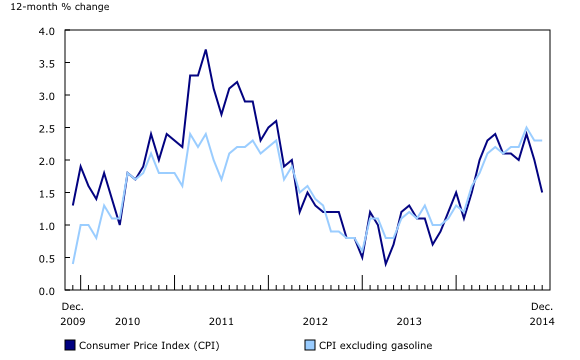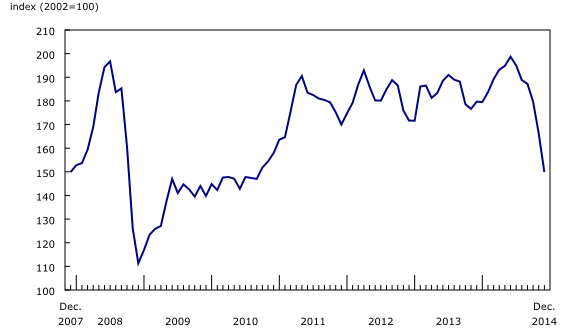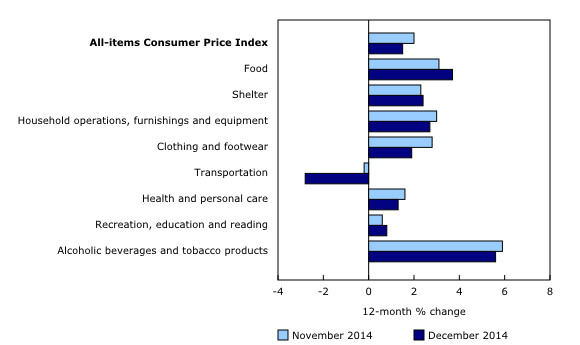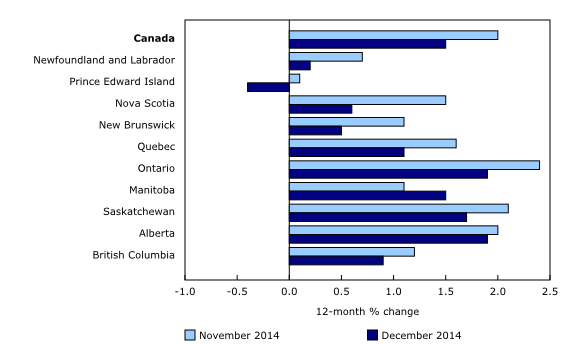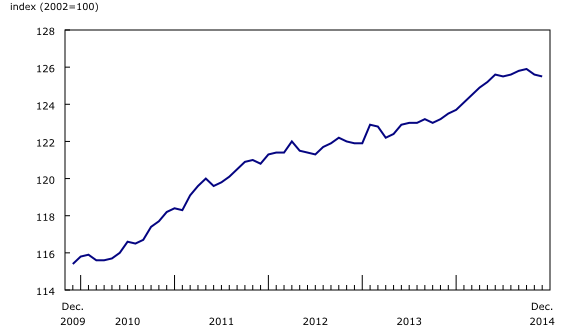Consumer Price Index, December 2014
Archived Content
Information identified as archived is provided for reference, research or recordkeeping purposes. It is not subject to the Government of Canada Web Standards and has not been altered or updated since it was archived. Please "contact us" to request a format other than those available.
Released: 2015-01-23
The Consumer Price Index (CPI) rose 1.5% in the 12 months to December, following a 2.0% increase in November.
Lower gasoline prices lead the deceleration in the Consumer Price Index
The slower year-over-year rise in the CPI was mostly attributable to gasoline prices, which dropped 16.6% in the 12 months to December, after falling 5.9% in November.
Excluding gasoline, the CPI increased 2.3% on a year-over-year basis in December, matching the rise in November.
On a monthly basis and before seasonal adjustment, the gasoline price index fell 9.8% in December. Between June and December 2014, gasoline prices decreased 24.6%. In comparison, prices for gasoline declined 42.7% between June and December 2008.
12-month change in the major components
Prices increased in seven of the eight major components in the 12 months to December. Higher shelter and food costs contributed the most to the rise in the CPI, while the transportation index, which includes gasoline, declined on a year-over-year basis for the second consecutive month.
The shelter index rose 2.4% in the 12 months to December, following a 2.3% gain in November. Natural gas prices increased 16.5% on a year-over-year basis in December, after recording a 14.7% rise the previous month. As well, electricity prices were up 4.3% year over year in December, following a 3.6% increase in November. In contrast, consumers paid less for fuel oil in December compared with the same month a year earlier.
Food prices advanced 3.7% on a year-over-year basis in December, after posting a 3.1% gain in November. Prices for food purchased from stores were up 4.2% in the 12 months to December, following a 3.3% increase the previous month. This acceleration was led by prices for fresh vegetables, which advanced 6.9% year over year in December, after rising 2.6% in November. Consumers also paid more for meat (+13.1%) and food purchased from restaurants (+2.5%) in December compared with the same month in 2013.
Transportation costs declined 2.8% in the 12 months to December as gasoline prices fell. Conversely, consumers paid 1.6% more for the purchase of passenger vehicles on a year-over-year basis in December.
12-month change in the provinces
Year-over-year change in consumer prices decelerated in nine provinces in December compared with November. Manitoba was the exception. Prince Edward Island was the only province to record a decline in its CPI in the 12 months to December.
Lower gasoline prices were observed in all provinces.
Consumer prices in Prince Edward Island declined 0.4% in the 12 months to December, marking the first decrease since October 2009. Gasoline prices in the province fell 18.5% year over year in December. In addition, the cost of fuel oil declined more in Prince Edward Island (-15.7%) than at the national level (-9.8%). The CPI basket weight for fuel oil is 10 times larger in this province than in Canada as a whole.
Manitoba was the only province where consumer prices rose more on a year-over-year basis in December (+1.5%) than in November (+1.1%). The clothing and footwear index in the province accelerated, rising 3.2% in the 12 months to December, after falling 2.7% the previous month.
Seasonally adjusted monthly Consumer Price Index decreases
On a seasonally adjusted monthly basis, the CPI decreased 0.1% in December, after declining 0.2% in November.
Of the eight major components, four declined and four increased on a seasonally adjusted monthly basis in December.
The seasonally adjusted transportation index fell 1.2% in December, the largest monthly decline of all the major components. This followed a 1.4% decrease in November.
Conversely, the seasonally adjusted food index (+0.5%) recorded the largest rise in December. This marked its fourth consecutive monthly gain on a seasonally adjusted basis.
Bank of Canada's core index
The Bank of Canada's core index rose 2.2% in the 12 months to December, after increasing 2.1% in November.
The seasonally adjusted core index rose 0.2% on a monthly basis in December, following a 0.1% increase in November.
Note to readers
A video providing an overview of the Consumer Price Index (CPI) is available on Statistics Canada's YouTube channel.
A seasonally adjusted series is one from which seasonal movements have been eliminated. Users employing CPI data for indexation purposes are advised to use the unadjusted indexes. For more information on seasonal adjustment, see Seasonally adjusted data – Frequently asked questions.
The Bank of Canada's core index excludes eight of the CPI's most volatile components (fruit, fruit preparations and nuts; vegetables and vegetable preparations; mortgage interest cost; natural gas; fuel oil and other fuels; gasoline; inter-city transportation; and tobacco products and smokers' supplies) as well as the effects of changes in indirect taxes on the remaining components.
Upcoming basket update
On February 26, 2015, with the release of the January CPI, the basket of goods and services used in the calculation of the CPI will be updated.
The new weighting pattern will be based on the 2013 Survey of Household Spending (SHS). It will replace the current weights, which are based on the 2011 SHS.
The index base period, for which the CPI equals 100, will remain 2002.
There will be no changes to the CANSIM table and vector numbers. There will be some minor changes to published index titles to clarify the definition of some series.
There has been and will continue to be ongoing work to update the CPI sample to make it more representative of Canadians' spending patterns. This work is part of the CPI Enhancement Initiative and includes sample increases to improve geographic, outlet and product coverage, as well as updates to the CPI product classification.
For a more detailed analysis, consult the publication The Consumer Price Index. The December 2014 issue of The Consumer Price Index, Vol. 93, no. 12 (Catalogue number62-001-X), is now available from the Browse by key resource module of our website under Publications.
More information about the concepts and use of the Consumer Price Index (CPI) are available online in The Canadian Consumer Price Index Reference Paper (Catalogue number62-553-X) from the Browse by key resource module of our website under Publications.
The CPI for January will be released on February 26.
Contact information
For more information, or to enquire about the concepts, methods or data quality of this release, contact us (toll-free 1-800-263-1136; 514-283-8300; infostats@statcan.gc.ca) or Media Relations (613-951-4636; statcan.mediahotline-ligneinfomedias.statcan@canada.ca).
- Date modified:


